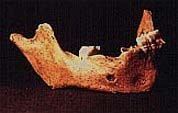 |
Enamel hypoplasia
Site: The Hirsel churchyard, Coldstream, Scotland.
Period: Medieval.
Excavator: Prof. R.J. Cramp, Durham University.
Published: forthcoming (Historic Scotland?).
Skeleton: child, c.7 years.
Catalogue entry: A disarticulated mandible of a child aged c.7 years, found with an older child (c.12 years). The first adult molars are fully erupted, but the seconds are unerupted. The adult incisors are almost fully erupted. Both juvenile canines have been lost post-mortem, and only one of the deciduous molars, the left second, is still in situ.
The teeth have gross hypoplastic lesions; the lower mesial incisors and the lower first molars each have three large ridges at the cementum-enamel junction. |